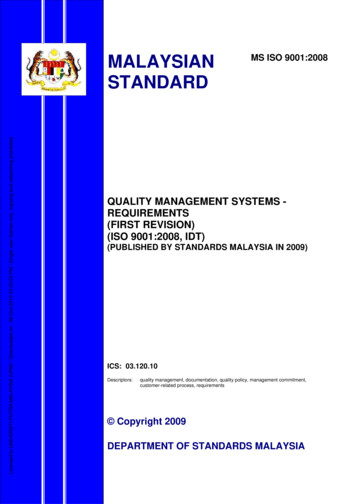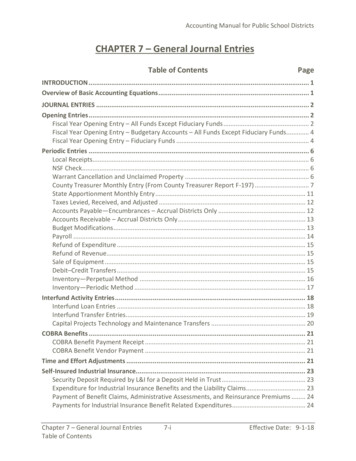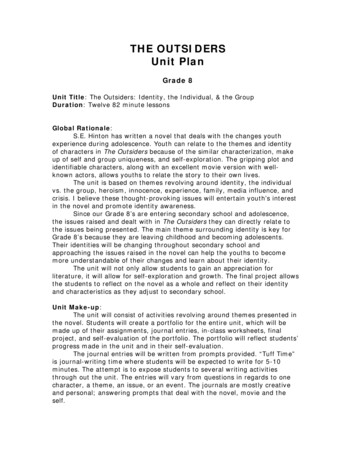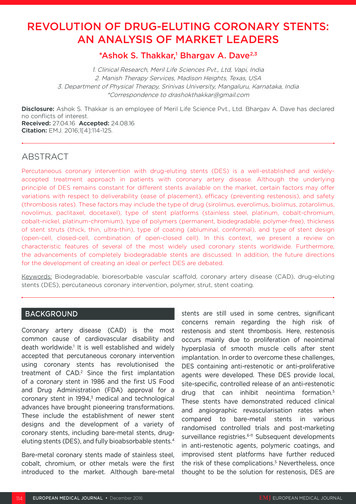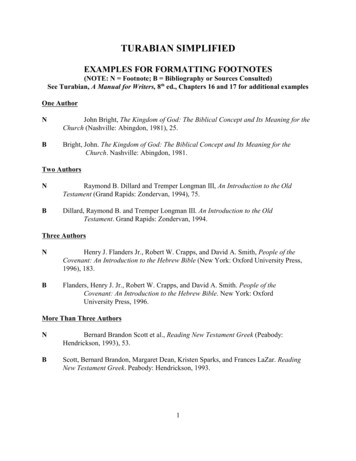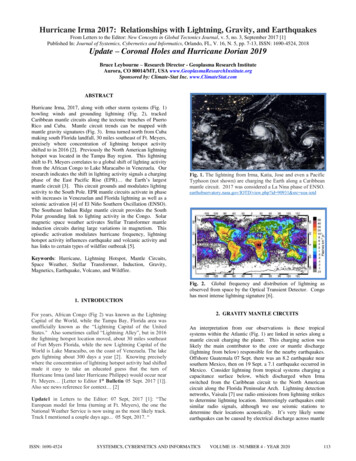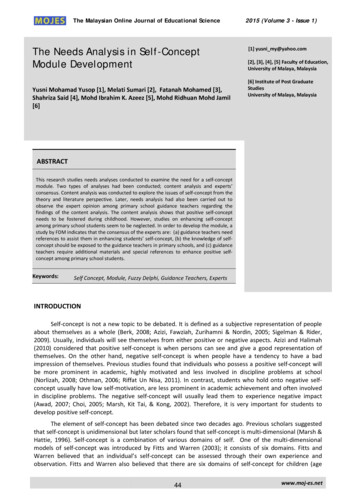
Transcription
The Malaysian Online Journal of Educational ScienceThe Needs Analysis in Self-ConceptModule DevelopmentYusni Mohamad Yusop [1], Melati Sumari [2], Fatanah Mohamed [3],Shahriza Said [4], Mohd Ibrahim K. Azeez [5], Mohd Ridhuan Mohd Jamil[6]2015 (Volume 3 - Issue 1)[1] yusni my@yahoo.com[2], [3], [4], [5] Faculty of Education,University of Malaya, Malaysia[6] Institute of Post GraduateStudiesUniversity of Malaya, MalaysiaABSTRACTThis research studies needs analyses conducted to examine the need for a self-conceptmodule. Two types of analyses had been conducted; content analysis and experts’consensus. Content analysis was conducted to explore the issues of self-concept from thetheory and literature perspective. Later, needs analysis had also been carried out toobserve the expert opinion among primary school guidance teachers regarding thefindings of the content analysis. The content analysis shows that positive self-conceptneeds to be fostered during childhood. However, studies on enhancing self-conceptamong primary school students seem to be neglected. In order to develop the module, astudy by FDM indicates that the consensus of the experts are: (a) guidance teachers needreferences to assist them in enhancing students’ self-concept, (b) the knowledge of selfconcept should be exposed to the guidance teachers in primary schools, and (c) guidanceteachers require additional materials and special references to enhance positive selfconcept among primary school students.Keywords:Self Concept, Module, Fuzzy Delphi, Guidance Teachers, ExpertsINTRODUCTIONSelf-concept is not a new topic to be debated. It is defined as a subjective representation of peopleabout themselves as a whole (Berk, 2008; Azizi, Fawziah, Zurihamni & Nordin, 2005; Sigelman & Rider,2009). Usually, individuals will see themselves from either positive or negative aspects. Azizi and Halimah(2010) considered that positive self-concept is when persons can see and give a good representation ofthemselves. On the other hand, negative self-concept is when people have a tendency to have a badimpression of themselves. Previous studies found that individuals who possess a positive self-concept willbe more prominent in academic, highly motivated and less involved in discipline problems at school(Norlizah, 2008; Othman, 2006; Riffat Un Nisa, 2011). In contrast, students who hold onto negative selfconcept usually have low self-motivation, are less prominent in academic achievement and often involvedin discipline problems. The negative self-concept will usually lead them to experience negative impact(Awad, 2007; Choi, 2005; Marsh, Kit Tai, & Kong, 2002). Therefore, it is very important for students todevelop positive self-concept.The element of self-concept has been debated since two decades ago. Previous scholars suggestedthat self-concept is unidimensional but later scholars found that self-concept is multi-dimensional (Marsh &Hattie, 1996). Self-concept is a combination of various domains of self. One of the multi-dimensionalmodels of self-concept was introduced by Fitts and Warren (2003); it consists of six domains. Fitts andWarren believed that an individual’s self-concept can be assessed through their own experience andobservation. Fitts and Warren also believed that there are six domains of self-concept for children (age44www.moj-es.net
The Malaysian Online Journal of Educational Science2015 (Volume 3 - Issue 1)between seven to 14 years). The six domains are physical, personal, moral, family, social and academic. Thedetails of the domains are shown in the Figure 1:SELFCONCEPTPhysicalAppearance, health, limbsPersonalAttributes: Honest, friendly, cheerful,calm, forgiving, and othersMoralGood, bad (values and act)FamilyParents, family members (obedience)SocialMake friends, mix around (friends/others)AcademicGifted/love Mathematics/cleverFigure 1: The Detailed Content of The Module Based On The Self-Concept Domains.Self-concept can be developed. It can also be reconstructed from a negative to a positive selfconcept (Franken, 2007). A number of previous studies conducted to enhance self-concept used theapproaches of individual or group counselling and group activities (Azman, 2000; Chua, 2011; Mohd AzizShah, 2010). The theory of Cooley stated that self-concept develops through social support (Oosterwegel &Oppenheimer, 1993; Shaffer, 2008). Guidance group activities are one example of the social support. Inschool, social support activity such as guided counselling activity grouping for students is a commonpractice (Gladding, 2003). Group guidance is important because it provides a space for individuals to learnthrough interaction with other group members. It is also one of the most effective approaches in helpingstudents to control their behaviour (Utusan Malaysia, 19 December 2012). This social support practice willgradually help students to develop and reconstruct their existing self concept. In fact, one of theappropriate programs can be conducted in group guidance is an activity that can increase the self-concept(Capuzzi & Stauffer, 2006).A module is a set of studies or programs which have been systematically planned and organized toachieve a number of objectives. The purposes of a module are to identify clearer objectives of the teachingsand to arrange activities more systematically (Russell, 1974; Sidek & Jamaludin, 2005). Module design is notonly for inside classroom learning process, but also for activities outside the classroom (McArdle, 2007). Amodule can be developed by using two approaches. First, the module development can be based on thestudy of certain theories, models, literature or the consensus of the experts. Second, the moduledevelopment can be adapted from the other existing modules or models to suit the needs of the study(Milano & Ullius, 1998; Richey & Klein, 2007).Module development is a developmental study that involves several phases and steps. Developmentof the module engaged with certain models of module development that suit the module objective. Anappropriate model of this study is the adaption of the Sidek Module Development Model (Sidek &Jamaludin, 2005). Based on the model, the module development in this study can be segregated into threephases:First Phase: Analysis (literature analysis and needs analysis)Second Phase: Design and development of the moduleThird Phase: Pilot study and evaluation of the module45www.moj-es.net
The Malaysian Online Journal of Educational Science2015 (Volume 3 - Issue 1)This article focuses on the first phase of the module development. Thus, only the analysis will bediscussed further.RESEARCH OBJECTIVEThis study aims at determining the importance of a self-concept module particularly for primaryschool students based on:1. Content analysis2. Consensus of the expertise among guidance teachers.METHODOLOGYThis research used content analysis and quantitative method. These methods were used in order toidentify whether the self-concept module is necessary in fostering positive self-concept. Content analysismethod was implemented to explore the relevant theory and literature regarding the significance of havingpositive self-concept since childhood while the quantitative method involved distributing questionnaires toexperienced primary school guidance teachers in order to get their feedback on the discussing issues.The Fuzzy Delphi Method (FDM) was conducted to get opinion from the experts. Similar to Delphitechnique, FDM is a procedure to determine the views and expert consensus on something (Anderson,1975; Brown, 1968; Dalkey, 1967). However, FDM application was applied to overcome the weaknesses inthe traditional Delphi technique such as the loss of data due to an iterative process which usually takes along time (Mohd Ridwan, Zaharah, Nurulrabihah, & Ahmad Arifin, 2014). Moreover, FDM is an approachwhich can avoid appointing a person who is not an expert as it needs lesser respondents compared toDelphi technique which requires large number of respondents (Saedah, 2008).SamplesIn this study, FDM was conducted to observe perceptions among the experts through questionnaires.This study involved 15 guidance teachers, comprising six male and nine female teachers currently serving inprimary schools. Criteria for sample selection are based on the skills and knowledge that they have in theguidance and counselling area, specifically for primary school students. The criteria to become an expert inthis study are;The expert must attend at least the Guidance and Counselling Course for Primary School Teacherwhich was organized by The Institute of Teacher Education;And The expert must have been working as a full time guidance teacher for at least five yearsOr The expert must have experience in the field of guidance and counselling for at least ten years (ifhe or she is a part time guidance teacher)The sample selected is based on voluntary basis. Jones and Twiss (1978) stated that the number ofexperts for the application of Fuzzy Delphi Technique is between 10 to 50 experts. This is also confirmed byAdler and Ziglo (1996) who claimed that if the agreement and consistency of experts is high, the number of10 to 15 experts is sufficient.ProceduresFDM was carried out by distributing questionnaires to the experts. As mentioned by Pa-Long, ChiungWen, and Po-Chein (2011), consensus of the experts could be done by means of questionnaires if theinterview cannot be implemented. In this study, the experts had been exposed to the content analysis in aworkshop. After the sharing session, the questionnaires were distributed to the experts, to determine theirconsensus on the5-points fuzzy scale questionnaire.FDM involves the use of fuzzy set theory, which has been integrated with classical Delphi method. ALikert scale chosen by the experts will be converted to a fuzzy scale by using fuzzy numbering which46www.moj-es.net
2015 (Volume 3 - Issue 1)The Malaysian Online Journal of Educational Scienceconsists of binary numbering terms (0 to 1). The fuzzy integration numbering will produce three grades,cited as the minimum value, most reasonable value and the maximum value that will be selected by anexpert. The questionnaire is shown in Table 1:Table 1 Questionnaire for Expert GC TeachersNo.StatementDegree of Agreement1.The development of self concept should benurtured in primary school123452.The knowledge of self-concept should be exposedto the guidance teachers in primary schools1234523453.Guidance teachers require additional materials/special reference to the formation of self-conceptfor primary school students1FINDINGSThe findings of the study are divided into two types which are the content analysis and the experts’consensus.Content AnalysisThe role of self-concept has been addressed in a number of psychological development theories. Oneof the theories is the Career Development Theory. In the Career Development Theory by Super, selfconcept is seen as a fundamental element to recognize oneself (Reardon, Sampson & Peterson, 2006;Srebalus, Marinelli & Messing, 1982). The theory had divided career development stages into five stageswhich are (a) Growth – from birth to middle teens (b) Exploration – from the age of 15 to 25 (c)Establishment – from mid 20s to mid 40s (d) Maintenance – from the age of 40s through the 60s (e)Disengagement or decline – late 60s through retirement. This theory also believes that the development ofself-concept occurs at every level of career development stages (Sharf, 2010).According to Capuzzi and Stauffer (2006), Super theory stresses that the careers chosen by a peopleare expression of their self-concept rather than their interest and ability. Individuals who think positively ofthemselves are believed to know more about their strengths. The more they know about their strengths,the more confident they are of themselves and confident individuals are more likely to develop and lead anautonomous life (Shraf, 2010). The autonomy is a foundation to express satisfaction through the selectionof career which involves the individuals’ abilities, interests, values and preferences. These are linked withthe role of the individuals in their lives through the theory of Super’s Career Rainbow (Herr & Cramer, 1996;Srebalus, Marinelli, & Messing, 1982). Super had clearly stressed that the career development process willmake excellent progress if development of self-concept occurs at the same time.Moreover, psychosocial development theory discovered that the self-concept development occursfrom the moment children are born. Erikson introduced a series of eight stages of psychosocialdevelopment of individuals throughout life (Sigelman & Rider, 2009). Each stage listed by Erikson has acertain conflict. The fourth stage is the conflict of industry versus inferiority which involves childrenbetween the ages of six to 12 years. This stage is characterized as an important moment to meet thechallenges which involve significant people and complex situations around them (Feldman, 2011). Thestage as mentioned by Erikson is shown in Table 2:47www.moj-es.net
The Malaysian Online Journal of Educational Science2015 (Volume 3 - Issue 1)Table 2 The Eight Stages of Psychosocial Development in Erikson’s TheoryErikson’s StageTrust versus mistrustDevelopmentalPeriodInfancy(first year)Autonomy versus shame/doubt1 to 3Initiative versus guilt3-6 yearIndustry versus inferiorityIdentity versus identity confusionIntimacy versus isolationGenerativity versus stagnationIntegrity versus despair6-12 year(or puberty)12-20 year20s-40s40s-50s60s onwardConflictTo develop a sense that the world is a safeplace.To realize oneself as an independent personwho can make decisionsTo develop the ability to try new things and tohandle failuresTo learn basic skills and to work with othersTo develop a lasting integrated sense of selfTo commit to another in a loving relationshipTo contribute to younger peopleTo view ones’ life as satisfactorySource. Kail and Cavanaugh (2010)Psychosocial Theory believes that self-development occurs throughout the individual’s life. Eriksonemphasised that past experiences are the root of present and future behavior, because the later stages arebuilt up from basis laid in the previous ones (Kail & Cavanaugh, 2010). Although no crisis is ever fullyresolved, the individuals must at least address the crisis of each stage sufficiently to deal with the demandsmade during the next stage of development (Santrock, 2009). Therefore, support and guidance from peoplewho are significant to the individuals seem to be crucial to help resolve conflicts and be more stable. Themore successful individuals resolve the crisis, the healthier the development will be.Besides the theories discussed in previous paragraphs, self-concept is also believed to play animportant role in enhancing motivation, achievement and socialization in an individual’s life. The literatureshows that self-concept has a positive relationship with motivation (Huang, 2012). In contrast, depressedpersons seem to have lower motivation. Individuals who have high self-concept tend to be more motivatedcompared with low self concept individuals. In addition, it is believed that self-concept means being able tocontrol oneself. Previous studies have shown that the self-concept works as self-control when self-conceptis closely related with the cognitive (Cumming, 2011). This is because having high self-concept is the resultof having positive thinking. High appreciation of oneself and having positive thinking then lead to the abilityto control one’s own self.Self-concept also plays an essential role in behavior formation. Findings from a study showed thatself-concept has a function in the behavior of students (Lewandowski, 2010). Students who have positiveself-concept are likely to be more confident to mingle with good people in their society. This situation couldprevent individuals from getting involved in problematic behavior or discipline problems. Indeed, previousstudies found that individuals' self-concept has a relationship with the socio-cultural aspect (English, 2007).This is because self-concept is influenced by the culture of the individual’s upbringing. Moreover, previousstudy also found that self-concept has a positive relationship with academic performance (Lewandowski,2011). Students with positive self-concept tend to have better achievement compared with those who havenegative self-concept. So, a positive self-concept is crucially important in developing a strong person,because individuals who have positive self-concept are more confident. This would help in developing astrong personality. And only strong personalities could assist individuals in facing the physiological changesespecially during the adolescence stage (Pantzicopoulos, 2006).The idea of self-concept is not only debated in theory and literature, but also stated in thedocuments of The Ministry of Education (KPM). One of the learning objectives in pre-school level is todevelop students’ positive self-concept (KSPK Document, 2010). At the same time, one of the learning aimsof primary school level is to foster students’ self-confidence (KSSR, 2011). These show that KPM hasstressed the fostering of positive self-concept in order to develop excellent personality among studentsthrough guidance activities (Surat Edaran, 2012). Although the matter of positive self-concept has been48www.moj-es.net
The Malaysian Online Journal of Educational Science2015 (Volume 3 - Issue 1)given attention by KPM, the application of fostering positive self-concept gets little action.Modules are available for enhancing self-concept. For instance, Self-concept Group Guidance Module(Chua, 2011; Mohd Aziz, 2010). However, these modules focus more on the development of positive selfconcept among secondary school students. Yet there are several modules dedicated for children, such asSelf-Enhancement Program Model “Circle Time” (Jabouin, 2008) and CBT manual for child depressiondisorder (Peratikos-Kiritsis, 2010). There is also the Self-Development Module (Bahagian PengurusanSekolah Harian, 2009; Mohamad Aziz Shah, Nazariah, & Pau Kee, 2011; Nazariah, Mohamad Aziz Shah, &Pau Kee, 2011). Nevertheless, these modules are not directed at enhancing self-concept specifically.Literature studies show that the references or modules to enhance the self-concept for primary schoolstudents are still lacking. Therefore, a self-concept module particularly for primary school students seemsto be needed.Findings of the content analysis as drawn in the Table 3:Table 3 The Findings of Content AnalysisSourceTheoryLiteratureKPM DocumentsResultFindingsa) Career development begins at the age of four, theself-concept development occurs in every stage ofCareer Developmentcareer development (five levels of career development)Theory (E. Super)b) The process of career development will be anexcellent move if development of self-concept occursat the same timeImplication: Foster the positive self-concept in early age to help individuals thinkpositive towards themselves and their futurea) The self-concept development occurs from themoment children are born (eight stages of selfdevelopment)b) Past experiences are the root of present and futurebehavior, because the later stages are built up frombasis laid in the previous onePsychosocial Developmentc) The fourth stage of self-concept developmentTheory (Erikson)involves children of preschool and primary school(crisis of this stage is “am I good as others?”)d) Although no crisis is ever fully resolved, theindividuals must at least address the crisis of each stagesufficiently to deal with the demands made during thenext stage of developmentImplication: Nurture the positive self-concept (especially during primary school) inorder to develop positive and excellent individuals in society.Self-concept is believed to play important roles in the individuals’ life such asenhancing: (a) motivation (b) achievement / academic (c) socialization (d) behaviourImplication: Students need to develop positive self-conceptPay much attention to enhance students positive self-concept through:a) KSPK Document - for preschool studentsb) KSSR Document – for primary school studentsc) Surat Siaran – for all studentsImplication: effort to nurture positive self-concept particularly among primaryschool students is neededThe reference to nurture positive self-concept for primary school students seems tobe neglected49www.moj-es.net
The Malaysian Online Journal of Educational Science2015 (Volume 3 - Issue 1)Experts ConsensusThe results of FDM in Table 4 shows the threshold (dm, n) for each item based on the experts’perception and overall percentage of threshold for the consensus group of the experts in guidance andcounselling for primary school. Overall, based on the percentage, the items were agreed upon by all theexperts. The items “The development of self concept should be nurtured in primary school” and “Theknowledge of self-concept should be exposed to the guidance teachers in primary schools” were agreed byexperts with percentage of d 0.2 are both 100% and average response value was .947 and .913respectively. Meanwhile the percentage of d 0.2 of item “Guidance teachers require additionalmaterials/ special reference to the formation of self-concept in elementary school students” is 93% agreedby experts, with average response value .882, as shown in Table 4:Table 4 Threshold Value and Percentage Consensus by Experts on Needs AnalysisExperts123456789101112131415d value in each itemd 0.2Percentage of d 0.2Average Respons 0.130.030.030.030.030.030.1391493%0.882Percentage consensus expert group to construct Self Concept Module is 93%From the analysis of threshold and percentage, there is consensus of all the experts on the need ofself-concept module.While Table 4 shows the defuzzification scores for the item of the need for Self-Concept Module.According to the defuzzification based on priority, the position of each item is given; this enables theresearcher to focus on the relevant characteristic in the content of the needs analysis for developing a selfconcept module.50www.moj-es.net
The Malaysian Online Journal of Educational Science2015 (Volume 3 - Issue 1)Table 5 Defuzzification Scores for Usability of Self Concept ModuleItemNo.1.2.3.Item Of Need For The ModuleThe development of self-concept should benurtured in primary schoolThe knowledge of self-concept should beexposed to the guidance teachers in primaryschoolsGuidance teachers require additionalmaterials/ special reference to the formationof self-concept in primary school .20ACCEPTED113.70ACCEPTED213.23ACCEPTED3As a result the defuzzification score of the characteristic of the need for the self-concept moduleappears in the value agreed upon by the experts. It is hereby agreed that all of the items are accepted asthe causes for the need for the self-concept module for primary school students. Table 5 shows that thedevelopment of self-concept should be nurtured in primary school with the defuzzification score 14.20.Accordingly, the experts agreed that the knowledge of self-concept should be exposed to the guidanceteachers in elementary schools with the score of 13.70. Guidance teachers require additional materials/special reference to the formation of self-concept in elementary school students obtained a defuzzificationscore of 13.10 as well.DISCUSSIONSelf-concept is crucial in developing the individual’s personality. Previous studies show that high selfconcept helps individuals to have better lead in life compared with those who have low self-concept (Awad,2007; Norlizah, 2008). In this regard, Fitts and Warren (2003) believed that self-concept is an entity of sixdomains, namely physical, personal, moral, social, family and academic. Thus enhancing the self-conceptmeans to foster positive thoughts among individuals about their physical, personal, moral, social, familyand academic life. Shaping positive ideas toward oneself should be done by nurturing love and appreciationon each of the six domains. Simultaneously KPM has emphasized that students should be fostered withpositive self-concept (Surat Siaran, 2012). However, the knowledge regarding self-concept specifically forprimary school students is still lacking and difficult to find in schools. This is confirmed by experts’consensus that guidance teachers need further references regarding self-concept. These materials couldassist them in helping students increase their positive self-concept.Furthermore, self-concept can be built up and reconstructed. Previous studies discussed theapproaches to increasing self-concept. Self-concept has a positive relation to individuals’ achievement,discipline and motivation. There should be a step to help primary school students foster their own positiveself-concept. Yet, teaching directly in enhancing self-concept topic is still less practised, even among theguidance teachers. Establishing positive self-concept is believed to have been started from the formation ofthought, which includes the idea and images of own self since early childhood. Yet, the previousapproaches focused more on teenage self-concept (Chua, 2011). On top of that, the experts agree guidanceteachers need a set of step by step plans to enhance positive self-concept. Hence the module of increasingprimary school students’ self-concept is necessary.It is significant to have positive self-concept. Having a positive self-concept would help individualsincrease their motivation and academic performance (Riffat Un Nisa, 2011). High self-concept also helps toassist individuals to enhance their good behavior. In addition, positive self-concept helps the individual tobe confident and socialize with fellow community members (Feldman, 2011). Referring to HumanDevelopmental Theory, self-concept has been developed since childhood (Hart & Damon, 1996). Throughthe data presented, the experts agree that the self-concept module to promote positive self-conceptamong the primary school students is essential to be provided in every school as it plays an important role51www.moj-es.net
The Malaysian Online Journal of Educational Science2015 (Volume 3 - Issue 1)in developing healthy and competent individuals.CONCLUSIONGenerally, the results of needs analysis discovered that self-concept which consists of six domains,known as physical, personal, moral, family, social and academic are crucial to be nurtured since childhood.The self-concept development occurs from the moment children are born. Individuals’ past experiences arethe root of present and future behavior, because the later stages are built up from the basis laid in theprevious one. So, it is crucial to nurture positive self-concept especially during the primary school, in orderto develop positive and excellent individuals in the society.Self-concept is the foundation of personality development that affects individuals’ behavior. Theexperts agree that self-concept should be fostered since elementary school to establish a firm positive selfconcept. In order to nurture the positive self-concept among students, the knowledge of self-concept oughtto be exposed to all guidance teachers in primary school. This will help them understand the things relevantto self-concept. Since there are not many particular references focused solely on self-concept of primaryschool students, the experts see that there should be structured materials prepared for guidance teachersto be used in helping students to increase positive self-concept. The findings suggest the need to develop aspecific reference or module on self-concept for primary school students.REFERENCESAwad, G. (2007, May). The Role of Racial Identity, Academic Self-Concept, and Self-Esteem in the Predictionof Academic Outcomes for African American Students Journal of Black Psychology, 33(2), 188-207.Aziz, M. S. (2011). The Effectiveness of Cognitive Behavioural Therapy (CBT) Treatment Group on Selfconcept Among Adolescentsohamed, Journal of Learning and Individual Differences , 1(8), pp. 113122.Azizi Yahaya, & Halimah Ma’alip. (2010). Estim kendiri remaja. Skudai, Malaysia: Penerbit UTM.Azizi Yahaya, Fawziah Yahya, Zurihanmi Zakariya, & Noordin Yahaya. (2005). Pembangunan kendiri.Universiti Teknologi Malaysia, Johor. UTM.Azman Mahsuri. (2000). Terapi Rasional Emotif: Tatacara intervensi pelajar yang mempunyai konsep kendirirendah (Tesis Sarjana yang tidak diterbitkan, Universiti Malaya, Kuala Lumpur).Bahagian Pengurusan Sekolah Harian, Kementerian Pendidikan Malaysia. (2009). Modul PerkhidmatanBimbingan dan Kaunseling Sekolah Rendah Tahun Empat – Enam.Berk, L. (2008). Exploring lifespan development. Boston, MA: Allyn & Bacon.Burger, J. M. (2000). Personality (5th ed.). Australia: Wadsworth Thomson Learning.Capuzzi, D., & Stauffer, M. D. (2006). Career counseling foundation, perspectives and application. Boston,MA: Pearson Allyn & Bacon.Choi, Namok. (2005). Self-efficacy and self-concept as predictors of college students’academicperformance, Psychology in the Schools, 42(2).52www.moj-es.net
The Malaysian Online Journal of Educational Science2015 (Volume 3 - Issue 1)Chua Lay Nee. (2011). Kesan intervensi kaunseling kelompok pendekatan Adlerian dan bimbingan kelompokKonsep Kendiri ke atas konsep kendiri pelajar sekolah menengah: Satu kajian perbandingan. (TesisPhD tidak diterbitkan UKM, Bangi).Corey, G. (2009). Theory and practice of counseling and psychotherapy (8th ed.). , Thomson BooksCole, Cumming, S. P., Standage, M., Loney, T., Gammon, Catherine, Neville, Helen, Sherar, Lauren B., &Malina, R. M. (2008). The mediating role of physical self-concept on relations between biological maturitystatus and physical activity in
about themselves as a whole (Berk, 2008; Azizi, Fawziah, Zurihamni & Nordin, 2005; Sigelman & Rider, 2009). Usually, individuals will see themselves from either positive or negative aspects. Azizi and Halimah (2010) considered that positive selfconcept is when person
